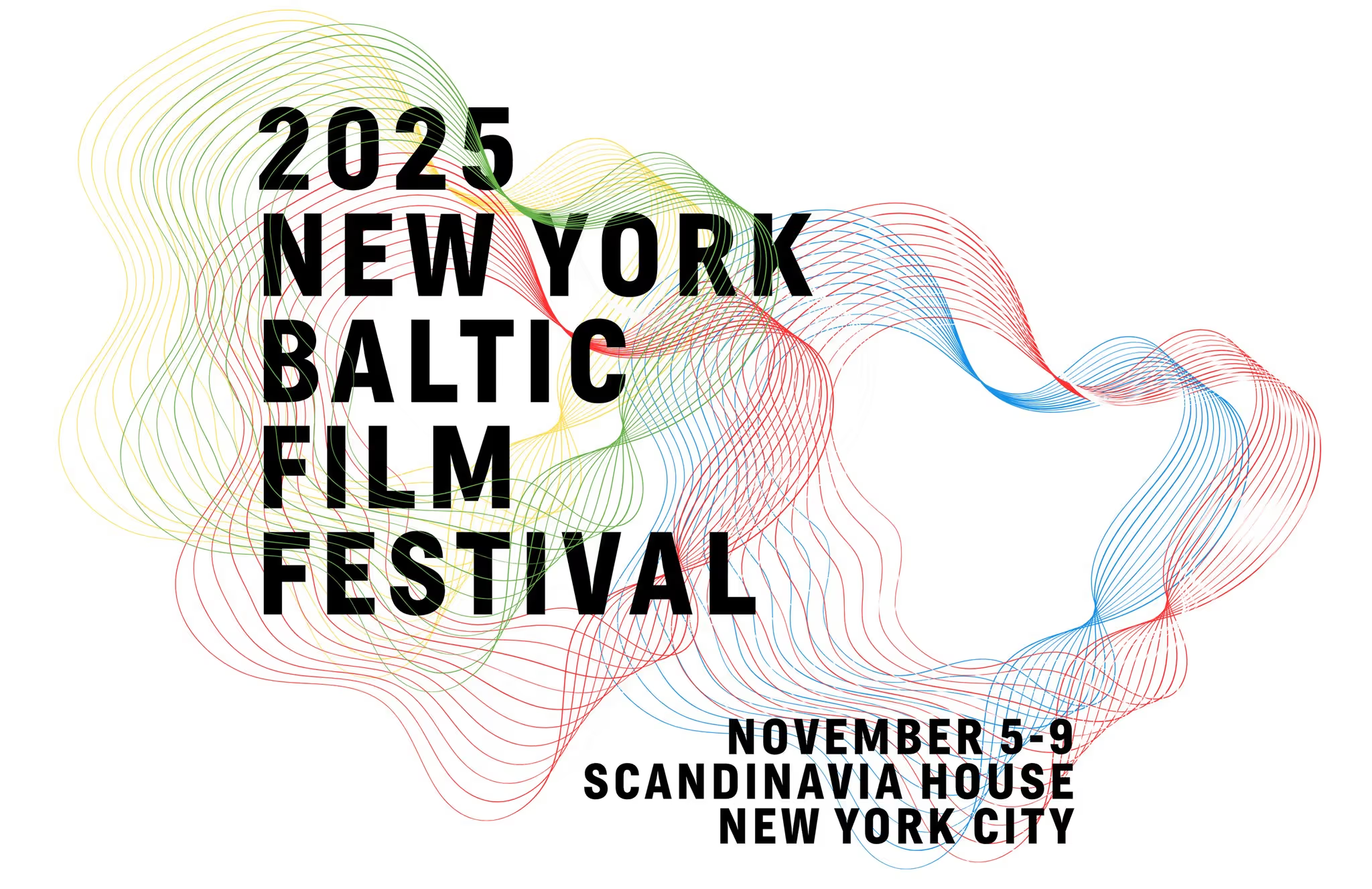Nordic and Baltic expatriates and culture enthusiasts in the U.S. and Canada are finding new avenues to celebrate their heritage, while American audiences gain fresh perspectives through these transatlantic cultural exchanges. The following explores some of the most notable recent collaborations – especially in hubs like New York City, Washington D.C., Minneapolis, Seattle, Los Angeles, and Chicago – and how they are weaving a rich, shared cultural tapestry.
Film Festivals: Seeing the World Through Nordic and Baltic Eyes
One of the most dynamic cross-cultural exchanges has come via cinema. In New York City, the New York Baltic Film Festival (NYBFF) has established itself as a premier showcase of Baltic filmmaking. Launched in 2018 and presented by Scandinavia House (the Nordic Center in America), the annual festival is organized in collaboration with the Baltic governments’ U.S. representatives – including Estonia’s Embassy, Latvia’s Mission to the UN, and Lithuania’s Consulate. Each autumn, NYBFF brings the latest award-winning films from Estonia, Latvia, and Lithuania to Manhattan, often with North American or international premieres. For example, the 2023 edition featured 13 screenings ranging from narrative features to documentaries, accompanied by director Q&As and even live concerts. The festival’s hybrid format has allowed in-person viewing at Scandinavia House in NYC and virtual streaming across the U.S., extending its reach to Baltic diaspora communities coast-to-coast. By “seeing the world through Baltic eyes,” American audiences are exposed to the unique histories and stories of the Baltic region, while Baltic filmmakers gain a transatlantic platform. The popularity of NYBFF underscores how a film festival can act as a cultural bridge, fostering mutual understanding through storytelling on screen.

New York’s film scene also embraces Nordic cinema beyond the Baltics. Scandinavia House regularly hosts Nordic film series, such as special festivals for Nordic nations. In March 2024, it presented West Nordic Film Days, celebrating cinema from Greenland, Iceland, and the Faroe Islands. Such events, often organized in partnership with Nordic cultural organizations, bring lesser-known “other Northern European” films to American audiences. Meanwhile on the West Coast, Seattle’s National Nordic Museum launched an inaugural West Nordic Film Festival, similarly highlighting films from Arctic Nordic communities. Whether through large festivals or boutique screenings, these cinematic collaborations allow Nordic and Baltic storytellers to connect intimately with U.S. viewers, bridging continents one film at a time.
Museums and Exhibits: Shared Heritage on Display
Museums and galleries have become important venues for Nordic–Baltic and American collaboration, mounting exhibitions that blend heritage with contemporary art. In New York City, Scandinavia House has been a focal point for such cultural programming. As the leading center for Nordic culture in the U.S., it hosts diverse exhibitions, concerts, lectures and more that illuminate the vitality of Denmark, Finland, Iceland, Norway, and Sweden. Recent exhibits at Scandinavia House exemplify the cross-disciplinary richness of Nordic–American partnerships. In 2024, the gallery presented “Fog Swept Cargo – Art from the Faroe Islands,” the first major showcase of the Faroe Islands’ contemporary art scene in the United States. Curated by Faroese art expert Kinna Poulsen, this exhibit introduced New Yorkers to the striking diversity of Faroese visual art – from abstract paintings to textiles and installations – and even highlighted the Faroe’s collaborative lithography studio Steinprent, which attracts artists worldwide. The exhibition was part of a broader Faroe Islands Culture Days program at Scandinavia House, complete with artist talks, workshops, and film screenings celebrating Faroese culture. By partnering with Faroese artists and institutions, this project brought a remote Nordic culture into direct dialogue with American audiences, demonstrating how geographic isolation can give way to cosmopolitan exchange through art.

Another innovative exhibit forging transatlantic ties is “Nordic Echoes – Tradition in Contemporary Art,” which opened at Scandinavia House in April 2025. Rather than importing art directly from the Nordic countries, Nordic Echoes showcases the creativity of Nordic-American artists in the U.S. Upper Midwest, exploring how Old World folk traditions have evolved in New World settings. Featuring 55 works by 24 artists from states like Minnesota, Wisconsin, and the Dakotas, the exhibition highlights Nordic craft skills (from Norwegian sheepskin rugs to Finnish ryijy textiles) kept alive by descendants in America. These works, infused with local materials and personal stories of identity, illustrate the malleability of tradition in a new environment. Significantly, Nordic Echoes itself is a collaborative venture: organized by the American-Scandinavian Foundation with support from U.S. arts endowments, it is a traveling exhibition that will tour Midwestern cultural institutions after its New York debut. Stops include the American Swedish Institute in Minneapolis and the Vesterheim Norwegian-American Museum in Iowa, ensuring that this Nordic–American artistic dialogue resonates in communities with deep Scandinavian roots. Through such traveling exhibits, an idea hatched in New York can journey to America’s heartland, strengthening cultural bridges along the way.
Seattle’s National Nordic Museum has likewise been at the forefront of transatlantic exhibitions. In 2024, it premiered “Nordic Utopia? African Americans in the 20th Century,” a groundbreaking show (co-curated by ASF fellows Ethelene Whitmire and Leslie Anderson) that explores the undertold stories of African American artists who sought creative refuge in Nordic countries during the last century. Figures like painter William H. Johnson and jazz icon Dexter Gordon found in Denmark, Sweden, or Norway a respite from Jim Crow racism and new artistic inspiration. Through artworks, music, and archival photos, Nordic Utopia? illuminates how Nordic societies offered these Black artists space to thrive and how their encounters abroad transformed their sense of identity. This exhibition itself traveled across the Atlantic (and continent): after debuting in Seattle in March 2024, it moved to New York’s Scandinavia House that November, marking a rare Seattle–NYC institutional collaboration. By highlighting a historical cultural exchange between African Americans and Nordics, the National Nordic Museum and its partners are not just preserving history – they are prompting today’s audiences to consider how openness and creativity transcend borders.

In the American Midwest, the American Swedish Institute (ASI) in Minneapolis has become a vibrant nexus for contemporary Nordic art and immigrant narratives. In early 2024, ASI hosted the U.S. stop of “Arctic Highways,” a special traveling exhibition featuring works by 12 Indigenous artists from Sápmi (the Nordic Arctic region of the Sámi people) and North America. Curated by Sámi artists Tomas Colbengtson, Gunvor Guttorm and others, Arctic Highways united creators across two continents to share the “unbounded” world of Arctic Indigenous art – from traditional handicrafts (duodji) to cutting-edge video installations. Notably, the exhibition included an immersive large-scale piece called Mygration, a collaboration between a Sámi artist and a Minneapolis Native American arts center, underscoring local partnership. The show’s opening at ASI was accompanied by community programming involving local Native artists and students, making it a truly cross-cultural dialogue on indigeneity and environment. Meanwhile, ASI’s gallery also spotlighted a very different kind of transatlantic story with “Salad Hilowle: Inscriptions,” which ran in 2025. Hilowle, a Swedish artist of Somali heritage, had his first major solo exhibition outside Sweden at ASI – a collaboration between the American Swedish Institute and Minneapolis’s Somali Museum. His multimedia art explores Afro-Swedish identity and the visibility of the African diaspora in Sweden, connecting historical archives with personal narrative. By partnering with the Somali Museum (which serves Minnesota’s large Somali-American community), ASI bridged Swedish and Somali diasporas in a single show, reflecting the complex cultural tapestry of today’s Nordic America.

Through these exhibits and many more, Nordic and Baltic art institutions are engaging in fertile exchange with their American counterparts. Whether it’s contemporary Faroese paintings in New York, Nordic-American folk art in the Midwest, or historical insights in Seattle, each collaboration creates a space where heritage and new ideas meet. These museum partnerships have proven especially powerful in cities with strong Nordic or Baltic immigrant legacies, reconnecting younger generations with their roots while inviting the broader public into the story. The result is a growing awareness that the cultural histories of Northern Europe and North America have long been intertwined – and that there is much to learn and celebrate at their intersection.
Music and Performance: Nordic Notes and Voices Across the Atlantic
Collaborative cultural bridges are also being built through music, theater, and performance. In Washington D.C., the Nordic diplomatic missions have actively teamed with local institutions to share their performing arts traditions. A prime example is the annual Nordic Jazz Festival, a series of concerts co-presented by the embassies of Denmark, Finland, Iceland, Norway, and Sweden in partnership with the DC Jazz Festival. Each summer, Nordic Jazz brings acclaimed musicians from Scandinavia and beyond to venues around the U.S. capital, often pairing them with American jazz artists. In recent editions, Finnish trios, Norwegian quartets, Danish–American ensembles and more have performed at sites like the House of Sweden (the Swedish Embassy) and the Kennedy Center’s Millennium Stage. The festival, now running for over 16 years, exemplifies how Nordic embassies collaborate with U.S. organizers to literally strike a chord between cultures, letting American jazz aficionados discover Nordic interpretations of the genre. Beyond D.C., similar musical exchanges occur in New York (Scandinavia House hosts Nordic chamber and folk concerts) and the Midwest (the Nordic Heritage Night at the Minnesota Orchestra, for instance), ensuring that Nordic sounds – from Finnish tango to Icelandic folk songs – resonate with American audiences. These performances are not one-off showcases but dialogues: as one Voice of America piece aptly noted, “Nordic Jazz brings U.S. and Scandinavia together,” fostering improvisational creativity across borders.
The performing arts have seen other inventive transatlantic pairings. Nordic theater and dance companies increasingly tour North America with support from cultural institutes. The Norwegian Ibsen Company and Swedish choreographers have appeared at New York theater festivals, while Minneapolis’s Guthrie Theater has hosted Finnish and Danish playwrights for residencies. On the West Coast, Seattle’s National Nordic Museum has incorporated performance into its programs – for example, staging Nordic folk dances and storytelling sessions during its Nordic Sól summer festival. Even film festivals double as performance venues: the Arctic Highways exhibition opening at Scandinavia House in NYC featured a Greenlandic mask dance and a Sámi joik singer live on stage, giving attendees a multisensory taste of Arctic culture alongside the visual art. Such moments show the power of performance to collapse distances – a Sámi chant echoing in Manhattan, or a Norwegian jazz riff floating over the Potomac – reminding expatriates of home and inviting new audiences into the fold.
.avif)
Design and Innovation: Creative Exchanges and Dialogues
Not to be overlooked are collaborations in design, architecture, and innovation, which have also flourished between the Nordic/Baltic region and North America. Nordic design – famed for its functional beauty and sustainability – has found enthusiastic partners in U.S. institutions. Scandinavia House in New York has made design a key part of its mission, hosting workshops and symposia that bring Nordic designers into conversation with American makers. A recent example is the Nordic Textile Takeover weekend in fall 2025, a program co-curated with the New York Textile Month festival. This event featured contemporary textile artists from across the Nordic countries (Denmark, Iceland, Faroe Islands, Finland, Norway, Sweden) and included hands-on workshops in traditional knitting, crochet, and fiber art techniques. With support from groups like the Icelandic Craft Council, the Textile Takeover demonstrated how Nordic craft traditions can inspire American creatives – participants crocheted Faroese-style motifs and repurposed vintage Scandinavian embroidery, guided by visiting Nordic artists. Such design collaborations celebrate shared values of craftsmanship and sustainability, and they introduce Nordic concepts (like the Swedish slöjd handcraft ethos) to new communities of artisans in North America.
On the West Coast, the Nordic Innovation Summit hosted annually by Seattle’s National Nordic Museum has broadened the idea of creative collaboration to include technology, urban design, and social innovation. These summits (even if business-focused) bring together Nordic and U.S. leaders in fields like architecture, green energy, and city planning to discuss common challenges. In 2024, the summit spotlighted “Nordic–US Collaboration for Livable Urban Futures,” drawing architects and policymakers from both sides of the Atlantic to exchange ideas on sustainable city design. By pairing Nordic innovations (for instance, Copenhagen’s biking infrastructure or Helsinki’s smart city tech) with American urban projects, the summit creates a platform for practical cultural exchange in design and innovation. Meanwhile, Los Angeles has seen the rise of NordicLA, a creative incubator supported by Nordic consulates that helps Nordic music producers, game developers, and designers connect with Hollywood and the U.S. entertainment industry. Programs like the NordicLA Music Summit and design talks have helped Nordic talent navigate and enrich the American creative scene, leading to collaborations in film scoring, fashion, and beyond. These efforts underline that transatlantic cultural collaboration isn’t only about fine arts – it’s also about shared creativity in how we design our lives and futures.
A Transatlantic Tapestry: Connecting Cultures and Communities
Across all these domains – film, art, music, design, and performance – the message is clear: Nordic and Baltic collaborations with U.S. institutions are building lasting bridges that benefit both sides of the ocean. For Nordic and Baltic artists, America offers new audiences and contexts to test the universality of their work. For American cultural institutions and communities, these partnerships provide fresh content, global perspectives, and a chance to engage with the rich traditions of Northern Europe. Nordic and Baltic expatriates in the U.S. and Canada, in particular, find pride and comfort seeing their heritage celebrated so prominently – whether it’s a Lithuanian film selling out a New York theater or a Sámi joiker enthralling listeners in Minneapolis. At the same time, many of these collaborations frame heritage in a contemporary, inclusive light: they highlight issues of today (climate, migration, identity, diversity) through the lens of culture and history, making the old relevant to new generations.
Importantly, institutions like Scandinavia House, the American Swedish Institute, the National Nordic Museum, and events like the New York Baltic Film Festival have shown sustained commitment, ensuring these cultural bridges are not one-off events but ongoing exchanges. Their work – often in tandem with Nordic and Baltic embassies, film institutes, universities, and community organizations – has created a robust network for transatlantic culture. New York City remains a major hub, with its constant roster of Nordic films, art exhibits, and performances, but it is complemented by efforts in Washington D.C. (embassy-driven festivals and exhibits), the Midwest (heritage museums and institutes), the West Coast (museums and innovation forums), and beyond. Even cities like Chicago (home to the Swedish American Museum and frequent Nordic concerts) and Los Angeles (with its Nordic creative industry initiatives) contribute essential threads to this tapestry of exchange.
As we look ahead, the momentum of Nordic–Baltic and American creative collaboration shows no signs of slowing. Upcoming film festivals promise more cross-border storytelling, new museum exhibitions will unearth further shared histories, and music and design partnerships will continue to spark inspiration on both continents. For Nordic and Baltic readers in North America – and indeed for anyone interested in transatlantic culture – these are exciting times. The distance between Minneapolis and Helsinki, New York and Tallinn, Seattle and Stockholm is shrinking in the cultural sense, thanks to the hard work of artists and institutions committed to connection. In an ever-globalizing world, these collaborations offer a hopeful narrative: one where celebrating one’s cultural roots goes hand-in-hand with building new, inclusive communities abroad. Through art and creativity, the Nordic and Baltic countries and the United States are composing a new chapter in their long-distance relationship – one of friendship, understanding, and shared cultural riches for all.













.png)
.png)
.png)
